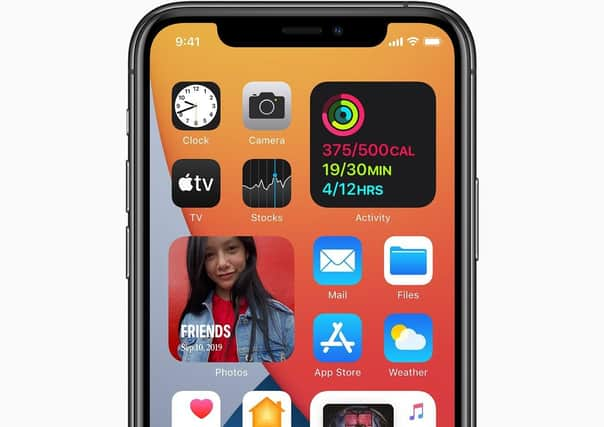Will iPhone’s new widgets tempt you away from Android?


It was in the summer of 2007 that Apple invented the smartphone as we know it. The first generation iPhone had a screen of just three-and-a-half inches from corner to corner and cost around £500. But it was a revelation – a phone, music player and internet browser in the same portable device, with a touchscreen to control them all.
More than six million were sold and as they disappeared from the shelves, the rest of the industry began playing catch-up.
Advertisement
Hide AdAdvertisement
Hide AdThe result was the Android phone, made at first by HTC, Samsung and Motorola and powered by software from Google. The first ones were crude and clumsy – nothing like the genuine iPhone – but with each successive iteration they got closer and, some would argue, better. In particular, Android phones had live tiles that displayed information on the home screen without having to open an app. These so-called widgets could be resized and moved freely around the screen, and became one of the platform’s most saleable features.
It has taken until now for Apple to embrace them.
The latest version of iOS, the annually-updated operating system behind iPhones and iPads, was announced last month and represents a radical departure from the grid layout that has characterised every model since that first one of 2007.
As of version 14, home screens will be able to make use of widgets in three sizes, placed elegantly amongst the regular icons. They can be stacked on top of one another and, if the preview event last month was any guide, they look cleaner and smarter than their Android equivalents. The iPad will benefit from them, too, although they will be sectioned off to the left of the home screen.
There have been Apple widgets before but never as an integrated part of the home screen, and their arrival will change the way many users interact with their phones.
Advertisement
Hide AdAdvertisement
Hide AdThe new operating system also includes, for the first time, picture-in-picture displays which will let you continue to watch YouTube or chat to a video caller while you flick through other apps on your phone.
And as if using your phone to pay at the supermarket till wasn’t enough technology, the iOS14 will also let it unlock and start your car – so long as your car is a 2021 model BMW 5 Series. Other manufacturers have yet to adopt or even trust the technology.
As is Apple’s usual practice, the announcement of these features has come several months ahead of their public release, in order to give developers a head start. You can expect software to be available for download in mid-September, but only if you have an iPhone 6s or a later model. The good news is that no more models have been rendered obsolete this year than last.
It’s unwise to get too carried away by software revisions but the significance of this one may be in tempting long-time Android users to consider an iPhone, perhaps for the first time. The new interface might also attract any remaining users of the now discontinued Windows Phone platform, which bears more than a passing similarity.
Advertisement
Hide AdAdvertisement
Hide AdIf you fall into one of those categories, the first thing you will notice about Apple’s range is how small it is by comparison. Your choice will be determined by price and screen size but as a guide, the newest iPhone 11, with a 6.1in display, will cost from £729, unlocked and free of any contract. That’s slightly cheaper in the long run than a two-year contract, which will typically involve an upfront payment of around £50 and then £40 a month, depending on the tariff.
That’s not cheap, but price is one area in which Apple has seldom been imitated.
Editor’s note: first and foremost - and rarely have I written down these words with more sincerity - I hope this finds you well.
Almost certainly you are here because you value the quality and the integrity of the journalism produced by The Yorkshire Post’s journalists - almost all of which live alongside you in Yorkshire, spending the wages they earn with Yorkshire businesses - who last year took this title to the industry watchdog’s Most Trusted Newspaper in Britain accolade.
Advertisement
Hide AdAdvertisement
Hide AdAnd that is why I must make an urgent request of you: as advertising revenue declines, your support becomes evermore crucial to the maintenance of the journalistic standards expected of The Yorkshire Post. If you can, safely, please buy a paper or take up a subscription. We want to continue to make you proud of Yorkshire’s National Newspaper but we are going to need your help.
Postal subscription copies can be ordered by calling 0330 4030066 or by emailing [email protected]. Vouchers, to be exchanged at retail sales outlets - our newsagents need you, too - can be subscribed to by contacting subscriptions on 0330 1235950 or by visiting www.localsubsplus.co.uk where you should select The Yorkshire Post from the list of titles available.
If you want to help right now, download our tablet app from the App / Play Stores. Every contribution you make helps to provide this county with the best regional journalism in the country.
Sincerely. Thank you.
James Mitchinson, Editor
Comment Guidelines
National World encourages reader discussion on our stories. User feedback, insights and back-and-forth exchanges add a rich layer of context to reporting. Please review our Community Guidelines before commenting.